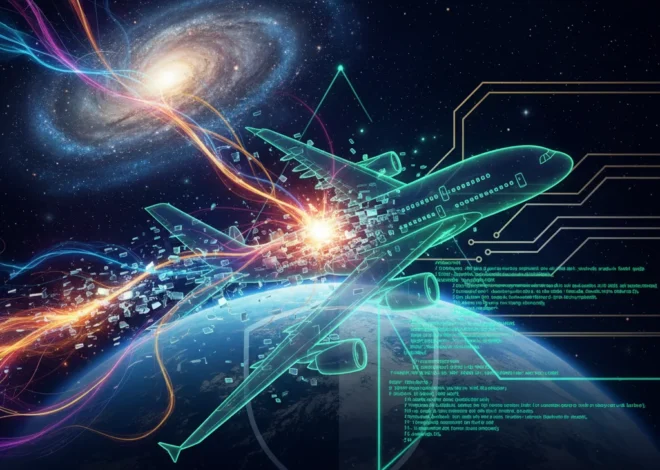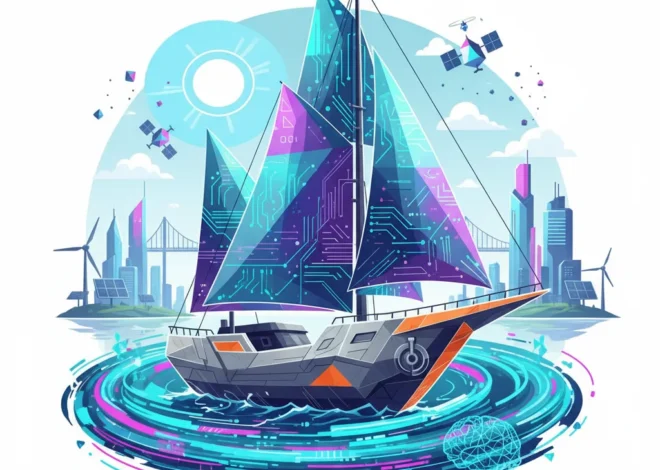
Europe’s Titans Assemble: Why Their New Space Alliance is a High-Stakes Bet on Software and AI
In the high-stakes chess game of the 21st-century space race, the board has been dominated by one king: Elon Musk’s SpaceX. With its reusable rockets, sprawling satellite constellations, and relentless pace of innovation, SpaceX hasn’t just entered the market; it has rewritten the rules. For years, the legacy giants of the aerospace world have watched, perhaps with a mix of admiration and alarm. But the time for watching is over.
In a move that signals a seismic shift in strategy, three of Europe’s largest defence and aerospace titans—Airbus, Leonardo, and Thales—have announced they are joining forces. Their stated goal is to create “significant synergies” to respond to the rapid expansion of their US rival, according to the Financial Times. But this alliance is about far more than just building bigger rockets or more satellites. It’s a belated but crucial recognition that the future of space will be won not just with hardware, but with software, data, and artificial intelligence.
For developers, entrepreneurs, and tech professionals, this isn’t just a story about aerospace. It’s a story about legacy industries grappling with digital disruption on a cosmic scale. It’s about how principles of cloud computing, SaaS, and automation are being applied to the final frontier, and what that means for the future of technology and innovation.
The SpaceX Disruption: From Hardware to a Software-Defined Universe
To understand the magnitude of this European alliance, we first need to appreciate the disruption SpaceX has unleashed. For decades, the “Old Space” model was characterized by government-funded, multi-year projects led by large, risk-averse contractors. The focus was on building exquisitely perfect, single-use hardware. It was reliable, but slow and incredibly expensive.
SpaceX flipped the script. They embraced a Silicon Valley mindset of rapid prototyping, iterative design, and, most importantly, vertical integration. By controlling everything from rocket manufacturing to launch operations and satellite deployment, they achieved unprecedented cost reductions and speed. But their true secret weapon isn’t just the reusable Falcon 9; it’s their software stack.
Starlink, SpaceX’s satellite internet constellation, is a prime example. It’s less a collection of satellites and more a globally distributed, software-defined network. The company pushes software updates to its thousands of satellites in orbit, constantly improving performance, optimizing routes, and deploying new features. This is a SaaS (Software-as-a-Service) model applied to space infrastructure, a concept that was science fiction a decade ago. This relentless pace of software-driven **innovation** is what legacy players are struggling to match.
A European “Avengers Assemble”: What the New Alliance Brings to the Table
Faced with this new reality, Airbus, Leonardo, and Thales realized that competing alone was a losing battle. By pooling their resources, they hope to create a European champion capable of standing toe-to-toe with SpaceX. This isn’t just a paper partnership; it’s a strategic alignment of complementary expertise.
- Airbus: A giant in both aviation and space, Airbus brings world-class experience in satellite design, manufacturing, and launch vehicle integration (via its stake in Arianespace).
- Leonardo: An Italian defence conglomerate, Leonardo specializes in high-tech sensors, avionics, and critical space robotics.
- Thales: A French multinational, Thales is a powerhouse in digital technologies, particularly in satellite communications, ground systems, and, crucially, **cybersecurity**.
The “significant synergies” they’re aiming for aren’t just about cost-cutting. The real goal is to create a seamless, integrated ecosystem from the ground up—fusing hardware design with a unified software platform and leveraging a shared pool of data. They aim to accelerate development cycles and move from the old, waterfall model of space projects to a more agile, iterative approach inspired by modern software **programming** methodologies. According to industry analysis, Europe’s share of the global space market has been under pressure, making this collaboration a strategic necessity for regional competitiveness (source).
The Billion Handshake: Why Tech Giants Are Pouring a Fortune into AI's Physical Backbone
To better understand the paradigm shift this alliance is attempting to navigate, let’s compare the traditional European model with the “New Space” approach pioneered by SpaceX.
| Characteristic | Traditional European Model | The SpaceX “New Space” Model | The New Alliance’s Aspiration |
|---|---|---|---|
| Development Model | Consortium-based, government-led, long-term contracts. | Vertically integrated, commercially driven, rapid iteration. | Integrated partnership, agile development, faster time-to-market. |
| Core Technology Focus | Perfecting bespoke, high-cost hardware. | Reusable hardware and a highly adaptable software stack. | Modular hardware platforms controlled by unified, upgradeable software. |
| Innovation Cycle | Decade-long cycles, risk-averse. | Months or weeks, embraces “successful failure.” | Accelerate to 18-24 month cycles through shared R&D and **automation**. |
| Supply Chain | Fragmented across multiple national suppliers. | Primarily in-house and highly controlled. | Streamlined and integrated across the three partners for efficiency. |
| Business Model | Selling hardware/launches to governments. | Selling services (launch, internet) directly; B2B and B2C. | Evolve towards a “Space-as-a-Service” (**SaaS**) model. |
The Real Battlefield: AI, Cloud, and Automation
While the headlines focus on rockets, the true battle for space dominance is being fought in the digital realm. Modern satellite constellations are essentially flying data centers, and managing them requires a level of sophistication that is impossible without cutting-edge software.
This is where the keywords that define modern tech become paramount:
- Artificial Intelligence (AI) and Machine Learning: Managing a constellation of hundreds or thousands of satellites is a monumental task. **AI** is essential for autonomous constellation management, collision avoidance, predictive maintenance, and intelligent data routing. On-board **machine learning** algorithms can process data directly on the satellite, reducing the need to send massive raw data files back to Earth.
- Cloud Computing: The sheer volume of data beamed down from space requires a robust and scalable **cloud** infrastructure on the ground. This “ground segment” is just as critical as the satellites themselves. The new alliance will need to build or partner on a powerful cloud platform to process, store, and distribute this information to customers.
- Automation: From manufacturing processes on the factory floor to satellite operations in orbit, **automation** is key to achieving the speed and cost-efficiency of New Space players. This includes automated testing, deployment pipelines, and operational health checks, all driven by sophisticated software.
For this European trio, success hinges on their ability to build a cohesive software ecosystem that can orchestrate these complex systems. It’s a massive challenge that will require attracting top-tier software engineers, AI researchers, and cloud architects—talent that has traditionally flocked to Silicon Valley, not legacy aerospace firms.
On paper, this is a formidable alliance. The combined engineering prowess and political clout of Airbus, Leonardo, and Thales are immense. But let’s be candid: the biggest obstacle they face isn’t technological, it’s cultural. Can these three bureaucratic behemoths, each with its own legacy processes and national interests, truly merge their cultures to become as agile and decisive as a company built in the image of a single, obsessive founder?
SpaceX’s advantage is its unified command structure and a culture that worships speed. This new European venture risks becoming a “super-committee,” where decisions are slowed by consensus-building and competing internal priorities. Their challenge is less about **programming** a satellite and more about reprogramming their corporate DNA.
My prediction? Success will be a direct function of their ability to empower a central, software-focused organization that can operate with the autonomy of a well-funded **startup**. If they get bogged down in politics and protectionism, they’ll simply create a bigger, slower version of what they already have. But if they genuinely embrace the agile, software-first ethos they’re aiming for, they could create a powerful counterbalance to American dominance and ignite a new wave of **innovation** in the European tech sector. The clock is ticking.
The Code War: Why Europe's Military Needs a Silicon Valley Reboot
The Ripple Effect: A New Frontier for Startups and Developers
This high-level corporate maneuvering has tangible implications for the broader tech community. The formation of this alliance is a massive signal that the European space industry is open for business in a new way. This creates a gravitational pull for talent and investment.
- Opportunities for Startups: A venture of this scale cannot build everything in-house. It will create a massive demand for a new ecosystem of European **startups** specializing in niche areas: AI-powered satellite imagery analysis, advanced **cybersecurity** solutions for space assets, novel propulsion systems, and specialized software for mission control. This alliance could become a major customer and partner for the European deep-tech scene.
- Demand for Tech Talent: The shift from a hardware-centric to a software-centric model means a surge in demand for developers. We’re talking about roles in embedded systems, distributed computing, cloud architecture, AI/ML engineering, and data science. For a developer looking to work on some of the most challenging problems in technology, the space industry is rapidly becoming one of the most exciting places to be. The need for secure and reliable code is paramount, making this a fascinating field for those passionate about quality **programming**.
A successful European space champion would not only secure the continent’s access to space but also create a powerful engine for technological development, fostering skills and companies that have applications far beyond the aerospace sector. One report highlighted that government and military contracts remain the lifeblood of many space companies, a sector this alliance is perfectly positioned to dominate in Europe (source).
The Trillion-Dollar AI Question: Are We in a Bubble or a Revolution?
Conclusion: The Final Frontier is Digital
The alliance between Airbus, Leonardo, and Thales is more than a corporate merger; it’s a declaration of intent. It’s Europe’s answer to the challenge posed by SpaceX and a recognition that the future of industry, security, and economic prosperity is inextricably linked to the digital infrastructure we build in orbit.
The path ahead is fraught with challenges, from overcoming internal bureaucracy to competing with the blistering pace of a rival that has a decade’s head start. But the mission is clear. The battle for the final frontier will be fought with algorithms as much as with rocket engines. It will be won with the cloud, secured with advanced cybersecurity, and optimized with artificial intelligence. For Europe, this alliance isn’t just about reaching for the stars; it’s about securing its place in a future that is being written, line by line, in code.


